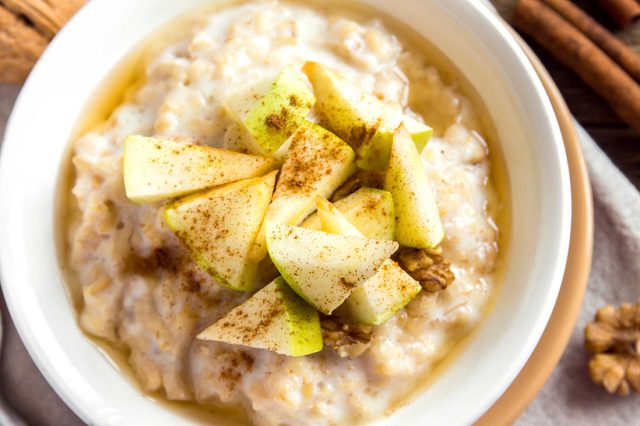
First, eat it
Even if your blood sugar is high in the morning, don’t skip breakfast. Research shows that forgoing a morning meal increases the risk for obesity and insulin resistance. And studies confirm that breakfast eaters are better able to resist fatty and high-calorie foods later in the day. Aim to eat your diabetic breakfast at the same time every day, since keeping your blood sugar levels even throughout the day means eating consistently from day to day.

Eat breakfast at home
You can’t (and shouldn’t) avoid restaurants altogether, but there’s one meal you should almost always eat at home: breakfast. Look at the alternatives: Diner-style breakfasts can include 1,000 calories or more with astronomical amounts of carbohydrates and fats. A healthy-sounding whole-wheat bagel with light cream cheese from a bagel shop may contain up to 67 grams of carbs, 450 calories, and 9 grams of fat. A sausage muffin may pack 29 grams of carbs, 370 calories, and 22 grams of fat. Compare those to a bowl of oatmeal (half a cup) with a half cup of fat-free milk, which contains a mere 12 grams of carbs, 195 calories, and 3 grams of fat.

Always top your cereal with fruit
We assume you’re already starting out with a cereal that contains at least 5 grams of fiber per serving. (Studies have found that people who regularly eat whole-grain cereal gain less weight than people who don’t.) Another important part of a balanced diabetic breakfast is fruit. Make it even more diabetes-friendly by adding half a cup (one serving) of fresh fruit, such as strawberries or blueberries. Check out more tasty superfoods all diabetics should enjoy.

Sprinkle 1 or 2 tablespoons of ground flaxseed on hot and cold cereal and yogurt
Rich in protein and fiber, these tiny seeds are a godsend to your blood sugar as well as your heart. They also contain fatty acids that the body uses to make the same type of omega-3 fatty acids you get from fish. Like fish, the seeds lower cholesterol and help guard again inflammation. Plus, their slightly nutty taste is delicious! Store whole seeds in the fridge, and grind the amount you need with a spice or coffee grinder.

Have oatmeal several days a week, especially in winter
Oatmeal is one of the best diabetic breakfasts you can eat. It contains 4 grams of fiber per cup, which will help keep blood sugar levels steady. And studies have shown that eating a cup of oatmeal five or six times a week can lower the risk of developing type 2 diabetes by 39 percent. Oatmeal also may help you eat less later in the day. One study found that people who ate oatmeal in the morning ate 30 percent fewer calories at lunch compared with people who ate sugared, flaked cereal for breakfast.

Have nonfat milk or yogurt with breakfast
When researchers studied 10,000 women, they found that the more calcium and vitamin D (which is added to fortified milk) the women consumed, the less likely they were to have metabolic syndrome, a cluster of symptoms that increases the risk of diabetes and heart disease. Vitamin D also helps the body use insulin, and consuming more calcium is associated with lower cholesterol levels. Drinking milk and eating dairy products help people lose weight, too. Just make sure you avoid the worst eating habits for diabetics.

Choose plain, nonfat yogurt over fruit yogurt
You can save 11 grams of carbohydrates this way. And don’t be fooled into thinking that vanilla yogurt has the same calories as plain; a cup of low-fat plain yogurt contains about 50 calories less than a cup of low-fat vanilla.

Have an orange instead of orange juice
Juice is a source of concentrated carbs and lacks the fiber of the whole fruit. And the fruit will make you feel more satisfied and full.

When you drink juice, use a real juice glass
Another important part of a diabetic breakfast is juice. It’s just 4 ounces. Fill it with orange juice, which contains 12 grams of carbs, instead of grape juice, which contains 16 grams of carbs. Don’t miss the best and worst drinks for diabetics.

Doctor your tea or coffee with cinnamon
One way to get more blood-sugar-lowering cinnamon is to add a cinnamon stick to your tea, or make a cinnamon tea by stirring a cinnamon stick in a cup of hot water. Or add half a teaspoon of powdered cinnamon to ground coffee before starting the pot.

Cook a large batch of steel-cut oatmeal on Sunday mornings
Enjoy one serving, and then refrigerate the rest. On weekday mornings, simply reheat in the microwave. Add raisins and cinnamon if you like. This will save you loads of time because steel-cut oatmeal takes as long as 50 minutes to cook.

Make your own flavored oatmeal
Instead of buying packets of flavored oatmeal, which usually contain added sugar and salt and use more-processed oats, make your own oatmeal with a few flavor boosters—and few diabetes busters! Start with old-fashioned or steel-cut oats and add chopped apples or peaches for sweetness (and fiber) and a generous sprinkling of blood-sugar-lowing cinnamon. Next, read about the snacks all diabetics should eat, and the ones they should skip.
